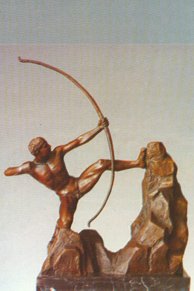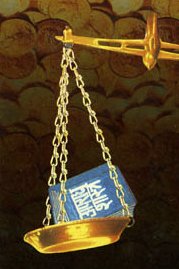Dhanurveda: 16 definitions
Introduction:
Dhanurveda means something in Hinduism, Sanskrit, Hindi. If you want to know the exact meaning, history, etymology or English translation of this term then check out the descriptions on this page. Add your comment or reference to a book if you want to contribute to this summary article.
Alternative spellings of this word include Dhanurved.
In Hinduism
Purana and Itihasa (epic history)
Source: archive.org: Puranic EncyclopediaDhanurveda (धनुर्वेद).—General information. A scientific treatise on the art of warfare in ancient Bhārata. Because of the undue importance of the science the treatise is deemed and respected as a Veda. There have been innumerable books on the subject to teach Dhanurveda to the Kṣatriya youths. In the book 'Prasthānabheda' by Madhusūdana Sarasvatī he states that Dhanurveda is a branch of Yajurveda. A Sanskrit book called Dhanurvedasaṃhitā is now available. Some scholars are of opinion that not much antiquity can be attributed to this work. Many books relating to Dhanurveda have been lost to us. What details are there in Agni Purāṇa are given below: (See full article at Story of Dhanurveda from the Puranic encyclopaedia by Vettam Mani)
Source: Cologne Digital Sanskrit Dictionaries: The Purana IndexDhanurveda (धनुर्वेद).—The science of war; taught by Droṇa to the Pāṇḍavas;1 Satyadhṛti well versed in;2 learnt by Kṛṣṇa and Rāma;3 personified,4 knowledge of, essential to a king; Prācetasas was an expert in;5 variety and detail of.6
- 1) Vāyu-purāṇa 61. 79. 91. 91. Viṣṇu-purāṇa III. 6. 28; IV. 19. 60. Bhāgavata-purāṇa I. 7. 44; III. 12. 38. Matsya-purāṇa 4. 47; 50. 9.
- 2) Bhāgavata-purāṇa IX. 21. 35; Matsya-purāṇa 215. 8.
- 3) Bhāgavata-purāṇa X. 45. 34; Brahmāṇḍa-purāṇa II. 35. 88; 37. 27.
- 4) Ib. IV. 17. 38-41; Matsya-purāṇa 220. 2.
- 5) Viṣṇu-purāṇa I. 14. 6.
- 6) Ib. V. 21. 21.

The Purana (पुराण, purāṇas) refers to Sanskrit literature preserving ancient India’s vast cultural history, including historical legends, religious ceremonies, various arts and sciences. The eighteen mahapuranas total over 400,000 shlokas (metrical couplets) and date to at least several centuries BCE.
Dhanurveda (science of warfare)
Source: Wisdom Library: DhanurvedaDhanurveda (धनुर्वेद) is the name of various Sanskrit works mentioned by Sri E.D. Kulkarni in his article “The Dhanurveda and its contribution to lexicography” (Bulletin of the Deccan College Research Institute Vol. 3, 1952):
- The Dhanurveda of Vasiṣṭha (Published),
- The Dhanurveda of Viśvāmitra (Mss. belongs to Tirupati Library No. 7493b),
- The Dhanurveda of Jāmadagnya,
- The Dhanurveda of Auśanasa,
- The Dhanurveda of Vaiśaṃpāyana.
- The Dhanurveda attributed to Śiva (Mss. belongs to Darbar Library, Nepal No. 557),
Dhanurveda (धनुर्वेद).—The existence of Dhanurveda or “Science of Archery” can be traced back to ancient time as is evident from referencesin several ancient literatures. Viṣṇu Purāṇa refers it as one of the eighteen branches of knowledge taught by Bhṛgu, while the Mahābhārata mentions it as having sutras like other vedas. Śukranīti describes it as that ‘upaveda of yajurveda’ which has five arts or practical aspects.
Besides providing the account of the training of the archers, Vasiṣṭha’s Dhanurveda describes difierent types of bows and arrows, process of making them, different steps inpractice teaching. Adoption of tāntric ways for wining the battle, worship of different gods for victory, application of herbs, charms as preventive measures in war, formation of arrays, duties of kings and army commanders, training of the elephants, horses have also been dealt with.
Source: archive.org: Catalogue of Pancaratra Agama Texts (dh)Dhanurveda (धनुर्वेद) is the name of a handbook dealing with weapons (as astra or as śastra), composed by Nārāyaṇa, as discussed in chapter 10 of the Ṛṣirātra section of the Sanatkumārasaṃhitā: an encyclopedic Sanskrit text written in over 3500 verses dealing with a variety of topics such as yoga, temple-building, consecration ceremonies, initiation and dhanurveda (martial arts).—Description of the chapter [śastra-lakṣaṇa]: Sanatkumāra offers to recount the story of how the weapons of the Lord came into being when the gods requested Nārāyaṇa to help them in their encounters with the demons. [...] He also composed a handbook, known as the Dhanurveda, which has been passed down from generation to generation. It tells how to use these weapons, both as astra or as śastra effectively. Of all the weapons, the best is the dhanus-bow—and there are several five-fold classifications of weapons given here, along with the five types of people who may most effectively use them, the five grips most sure to give careful aim, etc. (32-55).
Source: Knowledge Traditions & Practices of India: Martial Arts Traditions: A SurveyDhanurveda (धनुर्वेद), an ancient treatise on the science of archery and the art of warfare, enumerates the rules of archery, rules of bow- and arrow-making, and describes the uses of weapons and the training of the army. The treatise also discusses martial arts in relation to the training of warriors, charioteers, cavalry, elephant warriors, infantry and wrestlers.

Dhanurveda (धनुर्वेद) refers to the “knowledge of warfare” and, as an upaveda, is associated with the Ṛgveda. It contains instructions on warfare, archery and ancient Indian martial arts, dating back to the 2nd-3rd millennium BCE.
Arthashastra (politics and welfare)
Source: Shodhganga: Rajadharma in the MahabharataDhanurveda (धनुर्वेद).—Accordign to the first chapter of the Nītiprakāśikā:— The Dhanurveda is created by Brahmā to control wicked people and it is given to Prthu by fate. Dhanuraveda protects his subjects like father protects sons. Here, described about the nature of peace and war, six political principles, viz, (sandhi, vigraha, yāna, āsana, dvaidhībhāva and saṃśraya), possessing the six royal qualities (eloquence, fearlessness, wise, retentive memory, well versed in polity and gifted with originality), the seven state requisites, and consider all the fourteen faults, spies, and if the enemy is very weak than quickly attack with the three fold power, (king, minister and warlike enterprize), at the correct time a king should start the march.

Arthashastra (अर्थशास्त्र, arthaśāstra) literature concerns itself with the teachings (shastra) of economic prosperity (artha) statecraft, politics and military tactics. The term arthashastra refers to both the name of these scientific teachings, as well as the name of a Sanskrit work included in such literature. This book was written (3rd century BCE) by by Kautilya, who flourished in the 4th century BCE.
Shaivism (Shaiva philosophy)
Source: Shodhganga: Iconographical representations of ŚivaDhanurveda (धनुर्वेद) or Dhanurvedāgama refers to one of upāgamas (supplementary scriptures) of the Prodgītāgama which is one of the twenty-eight Siddhāntāgama: a classification of the Śaiva division of Śaivāgamas. The Śaivāgamas represent the wisdom that has come down from lord Śiva, received by Pārvatī and accepted by Viṣṇu. The purpose of revealing upāgamas (e.g., Dhanurveda Āgama) is to explain more elaborately than that of mūlāgamas (e.g., Prodgīta-āgama) and to include any new idea if not dealt in mūlāgamas.

Shaiva (शैव, śaiva) or Shaivism (śaivism) represents a tradition of Hinduism worshiping Shiva as the supreme being. Closely related to Shaktism, Shaiva literature includes a range of scriptures, including Tantras, while the root of this tradition may be traced back to the ancient Vedas.
Dharmashastra (religious law)
Source: Knowledge Traditions & Practices of India: Education: Systems & PracticesDhanurveda (धनुर्वेद) refers to the “science of warfare” and represents one of the divisions of the Upaveda (applied knowledge) class of knowledge, lying between that of the Paurūṣeya and Apaurūṣeya classification of Śāstra knowledge; all part of the ancient Indian education system, which aimed at both the inner and the outer dimension of a person.

Dharmashastra (धर्मशास्त्र, dharmaśāstra) contains the instructions (shastra) regarding religious conduct of livelihood (dharma), ceremonies, jurisprudence (study of law) and more. It is categorized as smriti, an important and authoritative selection of books dealing with the Hindu lifestyle.
Languages of India and abroad
Sanskrit dictionary
Source: Cologne Digital Sanskrit Dictionaries: Benfey Sanskrit-English DictionaryDhanurveda (धनुर्वेद).—m. the knowledge of the bow, of archery, the title of a sacred work, [Rāmāyaṇa] 5, 32, 9; [Johnson's Selections from the Mahābhārata.] 57, 161 (with sākṣāt, the embodied Dhanurveda).
Dhanurveda is a Sanskrit compound consisting of the terms dhanus and veda (वेद).
Source: Cologne Digital Sanskrit Dictionaries: Aufrecht Catalogus Catalogorum1) Dhanurveda (धनुर्वेद) as mentioned in Aufrecht’s Catalogus Catalogorum:—archery, by Śārṅgadatta. Report. Xxxvi.
2) Dhanurveda (धनुर्वेद):—Quoted by Kṣirasvāmin on Amarakośa, by Hemacandra Oxf. 185^b.
3) Dhanurveda (धनुर्वेद):—Peters. 4, 2.
4) Dhanurveda (धनुर्वेद):—Peters. 5, 113 (inc.).
—attributed to Sadāśiva (?). Rep. p. 9.
—from the Śārṅgadharapaddhati. Bd. 407.
5) Dhanurveda (धनुर्वेद):—from the Śārṅgadharapaddhati. Io. 1667. No. 4030. 2098. Peters. 5, 138.
Dhanurveda has the following synonyms: Vīracintāmaṇi.
Source: Cologne Digital Sanskrit Dictionaries: Monier-Williams Sanskrit-English Dictionary1) Dhanurveda (धनुर्वेद):—[=dhanur-veda] [from dhanur > dhanu] m. the science of archery, an a° treatise (regarded as an Upa-veda connected with the Yajur-veda, and derived from Viśvāmitra or Bhṛgu), [Mahābhārata; Harivaṃśa] etc.
2) [v.s. ...] Name of [work] by Śārṅga-datta, [Catalogue(s)]
3) Dhānurveda (धानुर्वेद):—[from dhānurdaṇḍika] m. = dhanur-veda, [Hemacandra’s Pariśiṣṭaparvan]
[Sanskrit to German]
Sanskrit, also spelled संस्कृतम् (saṃskṛtam), is an ancient language of India commonly seen as the grandmother of the Indo-European language family (even English!). Closely allied with Prakrit and Pali, Sanskrit is more exhaustive in both grammar and terms and has the most extensive collection of literature in the world, greatly surpassing its sister-languages Greek and Latin.
Hindi dictionary
Source: DDSA: A practical Hindi-English dictionaryDhanurveda (धनुर्वेद) [Also spelled dhanurved]:—(nm) the part of [yajurveda] which deals with the art and science of archery; the art and science of archery.
...
Kannada-English dictionary
Source: Alar: Kannada-English corpusDhanurvēda (ಧನುರ್ವೇದ):—[noun] the science of archery and military arts, considered as a sub-Veda.
Kannada is a Dravidian language (as opposed to the Indo-European language family) mainly spoken in the southwestern region of India.
See also (Relevant definitions)
Partial matches: Dhanus, Vedavedanga, Veda, Veta.
Starts with: Dhanurvedacintamani, Dhanurvedapara, Dhanurvedaparayana, Dhanurvedaprakarana, Dhanurvedasara.
Query error!
Full-text (+619): Dhanurvedacintamani, Dhanurvedaprakarana, Upaveda, Dhanurvedasara, Dhanurvedaparayana, Dhanurvedapara, Shastravidya, Tomara, Dhanurvedin, Sharnga, Viracintamani, Sharngadatta, Dhanus, Vidya, Kshatravidya, Cakra, Shivadhanurveda, Gada, Parashu, Trishula.
Relevant text
Search found 70 books and stories containing Dhanurveda, Dhanur-veda, Dhānurveda, Dhanurvēda, Dhanus-veda; (plurals include: Dhanurvedas, vedas, Dhānurvedas, Dhanurvēdas). You can also click to the full overview containing English textual excerpts. Below are direct links for the most relevant articles:
Architectural data in the Puranas (by Sharda Devi)
Notes and References for chapter 3 < [Chapter 4 - Forts]
Classification of Forts < [Chapter 4 - Forts]
Formal Education System in Ancient India (by Sushmita Nath)
The Gurukula centre of learning < [Chapter 3 - Centres of Learning in Vedic and Buddhist Period]
Subjects studied in the Epic Period < [Chapter 5 - Subjects studied in the Vedic and Buddhist period]
Education in the Brahmanic Period < [Chapter 1 - Introduction]
Gati in Theory and Practice (by Dr. Sujatha Mohan)
Gait identified in the martial arts of India < [Chapter 4 - Practice of Gati]
Vastu-shastra (Introduction to Indian architecture) (by D. N. Shukla)
(ii) The Architecture (Sthāpatya) < [Chapter 3 - The Architect and Architecture]
Puranic encyclopaedia (by Vettam Mani)
Kuntaka’s evaluation of Sanskrit literature (by Nikitha. M)
3. Śārṅgadharapaddhati in Kuntaka’s treatment < [Chapter 5 - Kuntaka’s Evaluation of some Stray Verses]
1. Kirātārjunīya in Kuntaka’s treatment < [Chapter 3 - Kuntaka’s estimation of Mahākāvyas of other Poets]
Related products
